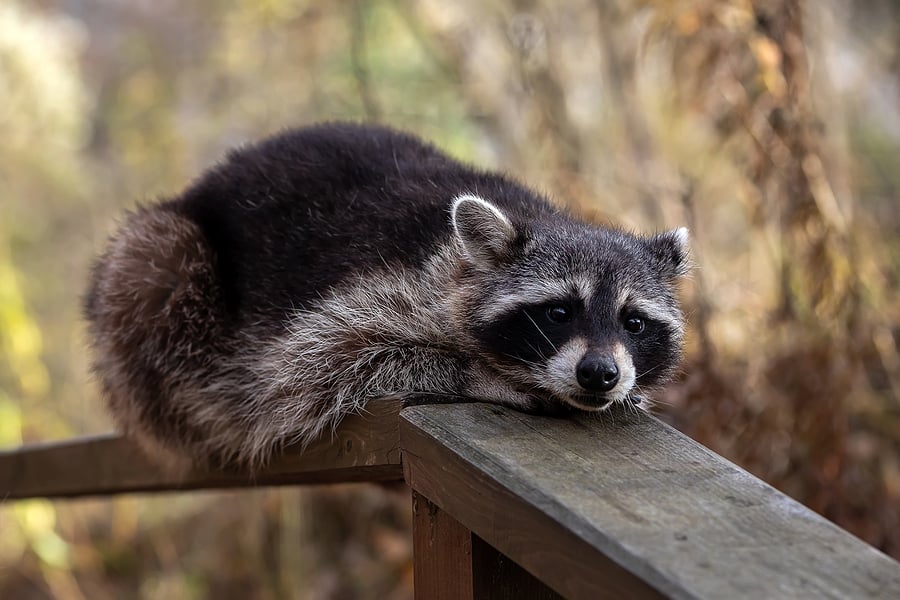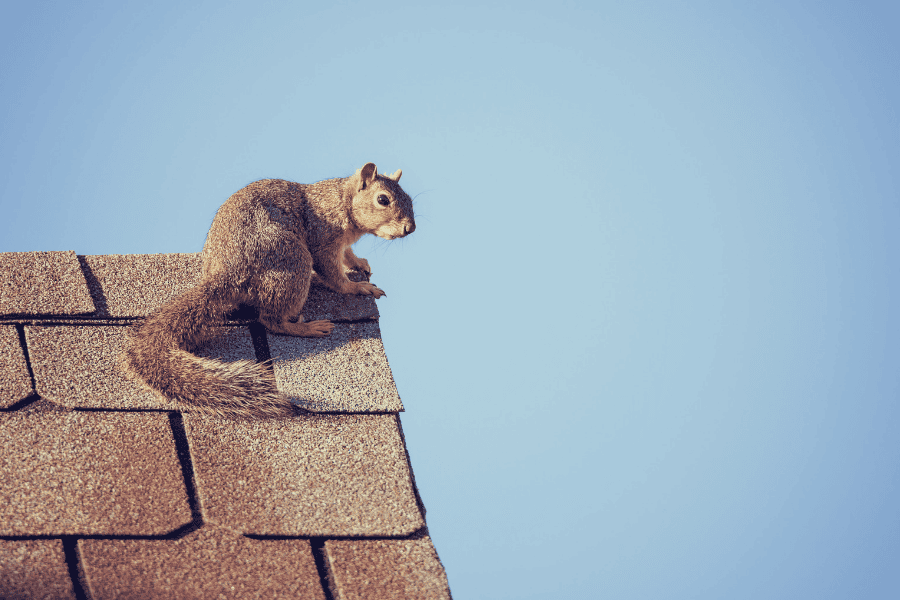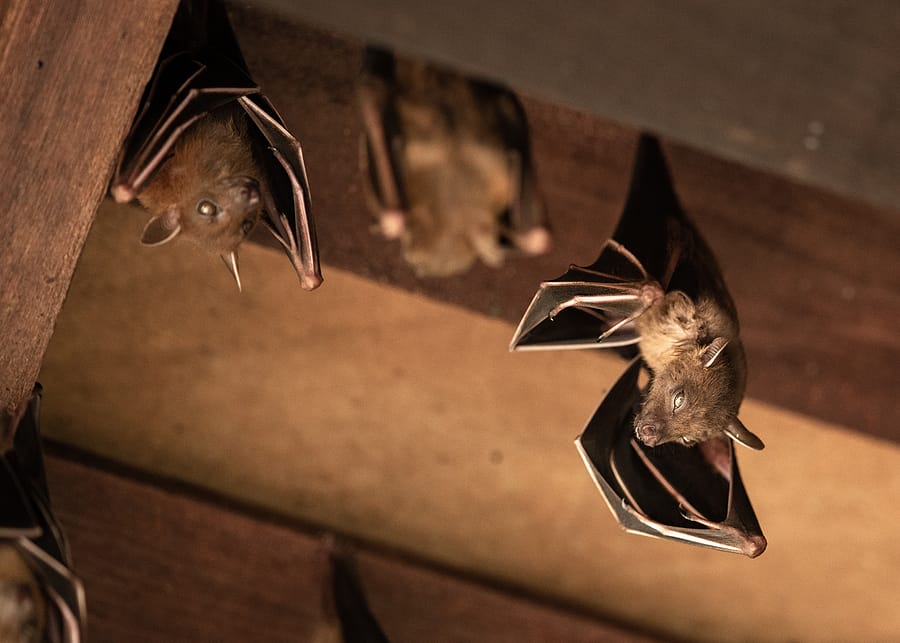READY TO GET STARTED?
REQUEST A FREE ESTIMATE
Fill out the form below or call (888) 466-7849 for a free, no-obligation estimate.

Raccoons are common wildlife found around homes or anywhere they can find an available food source. Although they look cute and cuddly, they are very aggressive when cornered and can cause significant damage to your home and yard.
Raccoons mate in February and March and litters are born 60-70 days after. They have anywhere from 2 to 5 kits per litter. Young raccoons are fully weaned and independent from their mothers in the summer, which is why we often see more of them this time of year. Mother raccoons are finding food and new nesting sites for their newly independent babies.
Raccoons will nest high in trees and are often found in our attics and crawlspaces. They are omnivores and will feed on anything, often raiding our trashcans for a meal. In late summer, they increase their food intake to build up their fat layers for the upcoming winter months.
Raccoons cause damage by upending trashcans and spreading trash across our yards, leaving droppings behind that contaminate our homes, urinating in attics which contaminates insulation and can cause mold, chewing through wires causing fire hazards, and shredding insulation for nests which can lead to costly damages and increased heating and air bills.
You can prevent raccoons by:

Summer is a time when wildlife is often more active and visible around your home. While it can be exciting to see these animals, it’s important to take precautions to keep them out of your home and prevent any potential damage. Here is the most common summer wildlife you’ll begin seeing soon and some tips on how you can keep these critters away!
Squirrels are a common sight in many neighborhoods during the summer. While they can be fun to watch, they can also cause damage to your home and property.
To prevent squirrels in your attic or crawlspace:
Raccoons are another common summer wildlife that you may find around your home. They can be attracted to garbage cans and compost bins.
To prevent raccoons from being attracted to your property:
Snakes are more active during the summer months and may be found around your home or yard. It’s not often that you’ll see venomous snakes near your property, but there are some that live in Georgia. Just be on the lookout while outside hiking or walking through wooded areas.
To prevent snakes from entering your home:
We hope these tips will help lessen the chances of wildlife finding their way indoors this summer. If you begin to suspect your home might have some uninvited guests, give your local wildlife control company a call today!

While Florida sees warmer temperatures year-round compared to other states, there’s bound to be a cold front hit during the winter season. Wildlife creatures look to our Harlem Heights homes for food, shelter, and warmth. Before they enter, it’s important for every homeowner to brush up on their knowledge of the types of winter wildlife and how to prevent them!
Rats and mice are notorious for entering our homes for shelter and food. These creatures are known to inhabit our crawl spaces, basements, kitchens, and attics. Once inside they can cause serious damage, such as chewing wire, destroying insulation, and leaving behind their feces.
Rats and mice are known to carry and spread diseases such as salmonella, lice, fleas, and ticks. Their droppings can also contain pathogens, dangerous to humans. Major signs of these creatures inside your home are hearing noises coming from the walls or ceilings, such as tapping or scratching.
Nocturnal animals, raccoons are dexterous, often opening doorknobs, cabinet doors, and trashcan lids to search for any available food source. These creatures are known to inhabit suburbs, and you will often find them invading hollow trees, attics, or garages.
Raccoons can cause significant damage to the outside of your home such as ripping of shingles, fascia boards, and even chimney vents! If they infest inside, they will destroy insulation, chew electrical wires, and contaminate the home with their urine and feces.
Bats are looking for a protected place that stays above freezing to inhabit. These creatures will often look to our attics for shelter, so they can huddle in a group together. If you suspect you have bats inside, don’t be surprised if there’s a group of them instead of just one. Bats will usually stay in attics during the day, leaving at night to search for a food source.
These creatures are known to carry diseases, such as rabies, which can spread to humans. In several states, removing bats is a delicate matter and will need to be done by a professional.
Preventing wildlife can seem daunting but there are a few easy ways you can keep them from invading your home. Check out our top wildlife prevention tips below:

Raccoons are highly adaptive pests that are capable of causing significant damage to your home. The two main reasons raccoons come around are a search for food and a search for a place to live. These wildlife creatures are easily recognizable with their ringed tails and mask-like markings on their faces. Their paws are dexterous, allowing them to access areas other pests can’t. Raccoons can bite when threatened and also carry diseases such as rabies, distemper, and parasites. They can cause damage to crawlspaces and attics by chewing through walls, sheetrock, etc.
Raccoons are nocturnal creatures and oftentimes can hang out around your house without you even realizing they are there. Here are 5 signs you may have a raccoon problem around your home.
Raccoons can become an issue when they take up residence in or near your home. Keep raccoons out of your home with these tips:
If you have a problem with raccoons or other wildlife, contact your local wildlife control company for a thorough inspection and wildlife control plan.

The weather is still a bit chilly, but spring is just around the corner and that means more wildlife will be out and about. Just because they left your attic alone this past winter doesn’t mean they won’t be attracted to it for the springtime. This is the time of year they will be searching for shelter to bear and rear their young. They are well-adapted to urban life and will typically be attracted to homes to find a safe place to settle down. Let’s go over which animals it’s time to keep an eye out for:
Most wildlife creatures are generally harmless but can be problematic if they get inside your home. Wildlife control begins with prevention. Here are some handy tips:
If you suspect a problem with wildlife or other pests, give your local wildlife control company a call today for a free inspection!